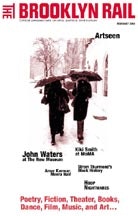ArtSeen
Leon Golub
Ronald Feldman Gallery
Leon Golub is a painter, who for most of his career has been considered a relentless political activist. He has always stuck to his own world view—a kind of persuasive skepticism, for which the oppressed condition and aggression became identifiable to his means of self-defense and personal dignity.
I must admit it took many years to warm up to Golub’s works. At first, I found the landmark images in his Vietnam series mercenary and torturous paintings, lacking the obvious firmness of what one may say is "good taste." But gradually they persist like a good insult, forcing one to deal with that aspect within oneself; as if you don’t know how to be ugly, you’re not beautiful. It’s a perpetual and lingering predicament, which similarly reminds me, not so much in style but content, of Guston’s late paintings. Ronald Feldman’s current display of Golub’s Graeco-Roman Colossi paintings dating from 1959 and 1964 invites me to revisit that rude awakening and reexamine the heavy handedness of the painter’s relationship to history.
Drawn from Greek pediment sculptures or rather fragments of the archaic period, Golub’s paintings adhere to their monumental and sculptural presence—surface abraded, almost sickening, they appear as if they had been run over by tanks and excavated by archeologists. I give Golub credit for having discovered his own lacquer technique as opposed to Pollock’s use of enamel house paint or Twombly’s oil crayons. The multitude of paint layers, carefully built by dripping paint, staining the canvas and scraping off pigment, create a flickering pattern into which the figure seems to dissolve. This relationship between figure and ground is based on ideas expressed by painters like Dubuffet or de Kooning, who insisted on the equal distribution of paint between the images and the background. Golub, on the other hand, is quite economical with his painting activities. Perhaps with the exception of "Colossal Torso II" (1959), which is his most lyrical and almost abstract painting, the visibility of an overall paint surface dominates the compositions. "Colossal III" painted in the same year has a strange bulkiness and anchoring gravity like an enormous rock on which Prometheus is bound. Here, one is reminded the old myths, a strong theme which reappears in some of his works of the later nineties.
Utilizing the unlimited resources of Greek mythology and current political history for his imagery and symbolism, Golub’s reading of the past and present essentially evokes the tension and discomfort of the figure as a sign for psychic and social identity. The recent series of small works on vellum entitled "Erotica, etc." (2000-2003) has a fresh and playful approach to lyricism, as well as an underlying urgency in its execution. I anticipate seeing how the artist will be able to transform them into his large-scale canvases.





